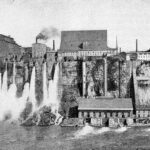“I have been at work for some time building an apparatus to see if it is possible for personalities which have left this earth to communicate with us”: Those are the words of the great inventor Thomas Edison in an interview in the October 1920 issue of The American Magazine. And in those days, when Edison spoke, people listened. By any measurement, Thomas Edison was a superstar in his time, a brilliant inventor during the height of the Industrial Revolution when man was mastering machine. Called “The Wizard of Menlo Park” (which has since been renamed Edison, New Jersey), he was one of history’s most prolific inventors, holding 1,093 U.S. patents. He and his workshop were responsible for the creation or development of many devices that changed the way people lived, including the electric light bulb, the motion picture camera and projector, and the phonograph.
Ghost of a Machine
But did Edison really invent a ghost box, a machine to talk to the dead?
Another interview with Edison published in the same month and year, this time by Scientific American, quotes him as saying, “I have been thinking for some time of a machine or apparatus which could be operated by personalities which have passed on to another existence or sphere.” (Emphasis mine.) So in two interviews conducted around the same time, we have two very similar quotes, one in which he says that he has been at work “building” the device, and in the other that he has merely been “thinking” about it. Somewhat contradictorily, the Scientific American article says, despite Edison’s quote, that “the apparatus which he is reported to be building is still in the experimental stage…” as if there is a prototype.
Although Edison seems to have gotten ahead of himself with this idea in The American Magazine interview, it’s quite clear that he had a genuine interest in the idea. While the Industrial Revolution was rolling along with a full head of steam, the Western world was also entertaining another movement of a very different sort—the Spiritualist movement. Operating at opposite ends of the philosophical spectrum—the logical, scientific, and mechanical versus the spiritual and ephemeral—the two movements were perhaps counterweights to each other.
Filling a Need
So why would Edison the scientist be interested in such a thing? Psychic mediums were all the rage, and they were conducting séances and spewing ectoplasm faster than Harry Houdini could debunk them. Phony mediums notwithstanding, it was becoming increasingly popular to think that it might be possible to communicate with the dead. And if it was at all possible, Edison reasoned that it could be accomplished through scientific means—a device that could do the job that mediums advertised.
Edison’s was a scientist’s approach: If there was a popular need or desire, an invention might be able to fill it. “I believe that if we are to make any real progress in the psychic investigation,” he said, “we must do it with scientific apparatus and in a scientific manner, just as we do in medicine, electricity, chemistry, and other fields.”
What Did Edison Have in Mind?
Edison revealed very few details about the device he intended to build. We can only speculate that he was either being a cautious businessman who didn’t want to say too much about his invention to potential rivals, or he didn’t really have many concrete ideas. “This apparatus,” he told Scientific American, “is in the nature of a valve, so to speak. That is to say, the slightest conceivable effort is made to exert many times its initial power for indicative purposes.” He then likened it to the mere turning of a valve that starts a huge steam turbine. In the same way, the barest whisper of effort from a spirit could influence the highly sensitive valve, and that action would be greatly magnified “to give us whatever form of record we desire for the purposes of investigation.”
He refused to divulge any more than that, but clearly Edison had in mind a ghost hunting tool. He went on to say that one of his employees who was working on the device recently died and that if the invention worked, “he ought to be the first to use it if he is able to do so.”
Again, we have no evidence for the device having been built, yet it is possible that it was constructed and then destroyed along with all the paperwork—perhaps because it didn’t work and Edison wanted to avoid embarrassment after his proclamations in the interviews.
Not Like Frank’s Box
The machine that Edison describes sounds nothing like today’s “ghost boxes,” and it is a mistake to assume that devices such as Frank’s Box were derived from Edison’s work. In fact, Frank Sumption, the inventor of Frank’s Box, has made no such claim. In 2007, he told Rosemary Ellen Guiley in an interview for TAPS Paramagazine that he was inspired by an article about EVP in Popular Electronics magazine. According to Sumption, his device is a simple of method of “supplying ‘raw’ audio that spirits and other entities can use to form voices.” It does so with a specially modified radio that sweeps its tuning across AM, FM, or shortwave bands. “The sweep can be random, linear or even done by hand,” Sumption says. The theory is that the spirits piece together words and phrases from these broadcasts to relay messages.
Ghost hunting groups from all over are creating and using their own ghost boxes, called Shack Hacks (because they employ modified Radio Shack portable radios), that work in the same way. (I have one, but have had very little success with it.)
Although some respected researchers, including Guiley, seem convinced of the reality of this phenomenon, the jury is still out regarding the authenticity of the communication. Although I have heard interesting bits and pieces from ghost boxes, I’ve yet to experience or hear recordings of ghost box sessions that are unambiguous and thoroughly convincing. Virtually everything that is heard (like many low-grade EVP) is open to interpretation.
Edison and Life After Death
As revealed in these interviews, Edison did not subscribe to conventional notions of life after death. He surmised that life was indestructible and that “our bodies are composed of myriads and myriads of infinitesimal entities, each in itself a unit of life.” Moreover, he saw the interconnectedness of all living things: “There are many indications that we human beings act as a community or ensemble rather than as units. That is why I believe that each of us comprises millions upon millions of entities, and that our body and our mind represent the vote or voice, whichever you wish to call it, of our entities…. The entities live forever…. Death is simply the departure of the entities from our body.”
“I do hope that our personality survives,” Edison said. “If it does, then my apparatus ought to be of some use. That is why I am now at work on the most sensitive apparatus I have ever undertaken to build, and I await the results with the keenest interest.”
Considering the remarkable track record of this incredible mind, we can only wonder how the world would be different had Edison somehow succeeded.










